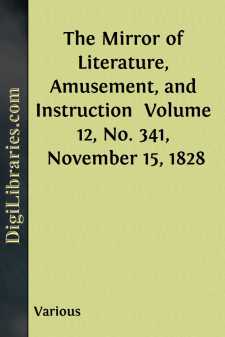Categories
- Antiques & Collectibles 13
- Architecture 36
- Art 48
- Bibles 22
- Biography & Autobiography 813
- Body, Mind & Spirit 142
- Business & Economics 28
- Children's Books 17
- Children's Fiction 14
- Computers 4
- Cooking 94
- Crafts & Hobbies 4
- Drama 346
- Education 46
- Family & Relationships 57
- Fiction 11829
- Games 19
- Gardening 17
- Health & Fitness 34
- History 1377
- House & Home 1
- Humor 147
- Juvenile Fiction 1873
- Juvenile Nonfiction 202
- Language Arts & Disciplines 88
- Law 16
- Literary Collections 686
- Literary Criticism 179
- Mathematics 13
- Medical 41
- Music 40
- Nature 179
- Non-Classifiable 1768
- Performing Arts 7
- Periodicals 1453
- Philosophy 64
- Photography 2
- Poetry 896
- Political Science 203
- Psychology 42
- Reference 154
- Religion 513
- Science 126
- Self-Help 84
- Social Science 81
- Sports & Recreation 34
- Study Aids 3
- Technology & Engineering 59
- Transportation 23
- Travel 463
- True Crime 29
The Mirror of Literature, Amusement, and Instruction Volume 12, No. 341, November 15, 1828
by: Various
Categories:
Description:
Excerpt
TEMPLE AT ABURY.
Sermons in stones
And good in every thing.—SHAKSPEARE.
What means the mysterious circle of stocks and stones on the other side? Such will be the question of many a lover of fun, novel, fiction, and romance; and though we cannot settle their origin with the quickness or the humour of Munden's Cockletop, we will try to let our inquirer into the secret with the smallest show of mysticism possible.
Our engraving represents the Temple of Abury, the most extensive of all the ruins in Wiltshire, attributed to the Druids. Such was its original state, before the Vandalism of modern times destroyed and levelled much of its monumental grandeur. It consisted of a grand circle, containing two minor circles. The outer circle contained upwards of 28 acres, and was surrounded by a ditch. There was a circle within each of the two circles, contained within the circumvallation; and according to Dr. Stukely, the antiquarian, the original was thus composed:—
Outward circle, within the vallum 100 stones
Northern Temple, outward circle 30 —
Ditto, inward circle 12 —
Cove, or cell 3 —
Southern Temple, outward circle 30 —
Ditto, inward circle 12 —
Central Obelisk 1 —
Ring Stone 1 —
The Temple occupied a spot to which there is a gradual and imperceptible ascent on all sides, and was approached by two avenues of two hundred stones each. Its general form was that of a snake, in by gone ages, the symbol of eternity and omniscience. "To make the form still more elegant and picture-like, the head of the snake is carried up the southern promontory of Hackpen Hill—and the very name of the hill is derived from this circumstance."
The whole figure thus represented the circle, snake, and wings. By this the founders meant to picture out the nature of the Divinity; the circle meant the supreme fountain of all being, the Father; the serpent, that divine emanation from him, which was called the Son; the wings imported that other divine emanation from them, which was called the Spirit, the Anima Mundi. That the Temple was of a religious, and not of a warlike nature, is proved by its ditch being withinside the agger of earth, contrary to the mode adopted in works of defence.
Of the devastation and decay of Abury, the following data will afford some idea:
The grand total of stones, included in the temples and avenues, was 650; in the original temples, 188.
In Aubrey's time, A.D. 1663 73 stones
In Dr. Stukeley's time, A.D. 1722 29 —
In 1815 17 —
Of very late years, says Sir Richard Colt Hoare, I do not imagine the dilapidations of the temple have been very great.
It should, however, be mentioned, that the tracing of the snake form is due to Dr. Stukeley; for his predecessor Aubrey mentions the avenue as "a solemn walk leading to a monument upon the top of the hill, without any allusion to the supposed design or its connexion with the Grand Temple at Abury."
It is a matter of greater speculation than we can here enter into, as to the date and founders of Abury; and their history is as dislocated as are the masses of its ruins....












